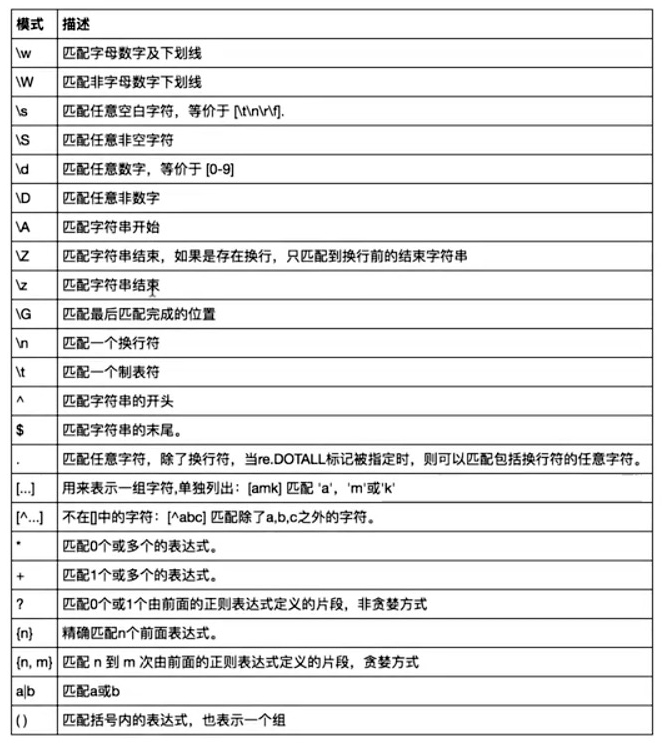python正则表达式
Posted _枝桠。
tags:
篇首语:本文由小常识网(cha138.com)小编为大家整理,主要介绍了python正则表达式相关的知识,希望对你有一定的参考价值。
正则表达式
正则表达式是一种用来模糊匹配字符串的方法,它的设计思想是用一种描述性的语言来给字符串定义一个规则,凡是符合规则的字符串,我们就认为它“匹配了”,否则该“没有匹配到该字符串”
在线调试工具:点击
一、常用正则表达式
- 单字符:
- . : 除换行以外所有字符
- [] :[aoe] [a-w] 匹配集合中任意一个字符
- \\d :数字 [0-9]
- \\D : 非数字
- \\w :数字、字母、下划线、中文
- \\W : 非\\w
- \\s :所有的空白字符包,括空格、制表符、换页符等等。等价于 [ \\f\\n\\r\\t\\v]。
- \\S : 非空白
- 数量修饰:
- * : 任意多次 >=0
- + : 至少1次 >=1
- ? : 可有可无 0次或者1次
- {m} :固定m次 hello{3,}
- {m,} :至少m次
- {m,n} :m-n次
- 边界:
- $ : 以某某结尾
- ^ : 以某某开头
- 分组:
- (ab)
- 贪婪模式: .*
- 非贪婪(惰性)模式: .*?
- re.I : 忽略大小写
- re.M :多行匹配
- re.S :单行匹配
- re.sub(正则表达式, 替换内容, 字符串)
|
1
2
3
4
5
6
7
8
9
10
11
12
13
14
15
16
17
18
19
20
21
22
23
24
25
26
27
28
29
30
31
32
33
34
|
import rekey=\'bobo@hit.edu.com\'#想要匹配到hit.res=re.findall(\'h.*\\.\',key)print(res) #[\'hit.edu.\']res=re.findall(\'h.*?\\.\',key)print(res) #[\'hit.\']#匹配出i开头的行string = \'\'\'fall in love with youi love you very muchi love shei love her\'\'\'res=re.findall(\'^.*\',string,re.M)print(res) #[\'fall in love with you\', \'i love you very much\', \'i love she\', \'i love her\']string1 = """<div>静夜思窗前明月光疑是地上霜举头望明月低头思故乡</div>"""res=re.findall(\'<div>(.*)</div>\',string1,re.S)print(res)#[\'静夜思\\n窗前明月光\\n疑是地上霜\\n举头望明月\\n低头思故乡\\n\']string1 = """<div>静夜思窗前明月光疑是地上霜举头望明月低头思故乡</div>"""res=re.findall(\'<div>(.*)</div>\',string1)print(res)#[] |

|
1
2
3
4
5
6
7
8
9
10
11
12
13
14
15
16
17
18
19
20
21
22
23
24
25
26
27
28
29
30
31
32
33
34
35
36
37
38
39
40
41
42
43
44
45
46
47
48
49
50
51
52
53
54
55
56
57
58
59
60
61
62
63
64
65
66
67
68
69
70
71
72
73
74
75
76
77
78
79
80
81
82
83
84
85
86
87
88
89
90
91
92
93
94
95
96
97
98
99
100
101
102
103
104
105
106
107
108
109
110
111
112
113
114
115
116
117
118
119
120
121
122
123
124
125
126
|
# =================================匹配模式=================================#一对一的匹配# \'hello\'.replace(old,new)# \'hello\'.find(\'pattern\')#正则匹配import re#\\w与\\Wprint(re.findall(\'\\w\',\'hello egon 123\')) #[\'h\', \'e\', \'l\', \'l\', \'o\', \'e\', \'g\', \'o\', \'n\', \'1\', \'2\', \'3\']print(re.findall(\'\\W\',\'hello egon 123\')) #[\' \', \' \']#\\s与\\Sprint(re.findall(\'\\s\',\'hello egon 123\')) #[\' \', \' \', \' \', \' \']print(re.findall(\'\\S\',\'hello egon 123\')) #[\'h\', \'e\', \'l\', \'l\', \'o\', \'e\', \'g\', \'o\', \'n\', \'1\', \'2\', \'3\']#\\n \\t都是空,都可以被\\s匹配print(re.findall(\'\\s\',\'hello \\n egon \\t 123\')) #[\' \', \'\\n\', \' \', \' \', \'\\t\', \' \']#\\n与\\tprint(re.findall(r\'\\n\',\'hello egon \\n123\')) #[\'\\n\']print(re.findall(r\'\\t\',\'hello egon\\t123\')) #[\'\\n\']#\\d与\\Dprint(re.findall(\'\\d\',\'hello egon 123\')) #[\'1\', \'2\', \'3\']print(re.findall(\'\\D\',\'hello egon 123\')) #[\'h\', \'e\', \'l\', \'l\', \'o\', \' \', \'e\', \'g\', \'o\', \'n\', \' \']#\\A与\\Zprint(re.findall(\'\\Ahe\',\'hello egon 123\')) #[\'he\'],\\A==>^print(re.findall(\'123\\Z\',\'hello egon 123\')) #[\'he\'],\\Z==>$#^与$print(re.findall(\'^h\',\'hello egon 123\')) #[\'h\']print(re.findall(\'3$\',\'hello egon 123\')) #[\'3\']# 重复匹配:| . | * | ? | .* | .*? | + | {n,m} |#.print(re.findall(\'a.b\',\'a1b\')) #[\'a1b\']print(re.findall(\'a.b\',\'a1b a*b a b aaab\')) #[\'a1b\', \'a*b\', \'a b\', \'aab\']print(re.findall(\'a.b\',\'a\\nb\')) #[]print(re.findall(\'a.b\',\'a\\nb\',re.S)) #[\'a\\nb\']print(re.findall(\'a.b\',\'a\\nb\',re.DOTALL)) #[\'a\\nb\']同上一条意思一样#*print(re.findall(\'ab*\',\'bbbbbbb\')) #[]print(re.findall(\'ab*\',\'a\')) #[\'a\']print(re.findall(\'ab*\',\'abbbb\')) #[\'abbbb\']#?print(re.findall(\'ab?\',\'a\')) #[\'a\']print(re.findall(\'ab?\',\'abbb\')) #[\'ab\']#匹配所有包含小数在内的数字print(re.findall(\'\\d+\\.?\\d*\',"asdfasdf123as1.13dfa12adsf1asdf3")) #[\'123\', \'1.13\', \'12\', \'1\', \'3\']#.*默认为贪婪匹配print(re.findall(\'a.*b\',\'a1b22222222b\')) #[\'a1b22222222b\']#.*?为非贪婪匹配:推荐使用print(re.findall(\'a.*?b\',\'a1b22222222b\')) #[\'a1b\']#+print(re.findall(\'ab+\',\'a\')) #[]print(re.findall(\'ab+\',\'abbb\')) #[\'abbb\']#{n,m}print(re.findall(\'ab{2}\',\'abbb\')) #[\'abb\']print(re.findall(\'ab{2,4}\',\'abbb\')) #[\'abbb\']print(re.findall(\'ab{1,}\',\'abbb\')) #[\'abbb\'] #\'ab{1,}\' ===> \'ab+\'print(re.findall(\'ab{0,}\',\'abbb\')) #[\'abbb\'] #\'ab{0,}\' ===> \'ab*\'#[]print(re.findall(\'a[1*-]b\',\'a1b a*b a-b\')) #[]内的都为普通字符了,且如果-没有被转意的话,应该放到[]的开头或结尾 #[\'a1b\', \'a*b\', \'a-b\']print(re.findall(\'a[^1*-]b\',\'a1b a*b a-b a=b\')) #[]内的^代表的意思是取反,所以结果为[\'a=b\']print(re.findall(\'a[0-9]b\',\'a1b a*b a-b a=b\')) #结果为[\'a1b\']print(re.findall(\'a[a-z]b\',\'a1b a*b a-b a=b aeb\')) #结果为[\'aeb\']print(re.findall(\'a[a-zA-Z]b\',\'a1b a*b a-b a=b aeb aEb\')) #结果为[\'aeb\', \'aEb\']#\\# print(re.findall(\'a\\\\c\',\'a\\c\')) #对于正则来说a\\\\c确实可以匹配到a\\c,但是在python解释器读取a\\\\c时,会发生转义,然后交给re去执行,所以抛出异常print(re.findall(r\'a\\\\c\',\'a\\c\')) #r代表告诉解释器使用rawstring,即原生字符串,把我们正则内的所有符号都当普通字符处理,不要转义 [\'a\\\\c\']print(re.findall(\'a\\\\\\\\c\',\'a\\c\')) #同上面的意思一样,和上面的结果一样都是[\'a\\\\c\']#():分组print(re.findall(\'ab+\',\'ababab123\')) #[\'ab\', \'ab\', \'ab\']print(re.findall(\'(ab)+123\',\'ababab123\')) #[\'ab\'],匹配到末尾的ab123中的abprint(re.findall(\'(?:ab)+123\',\'ababab123\')) #findall的结果不是匹配的全部内容,而是组内的内容,?:可以让结果为匹配的全部内容 [\'ababab123\']print(re.findall(\'href="(.*?)"\',\'<a href="http://www.baidu.com">点击</a>\'))#[\'http://www.baidu.com\']print(re.findall(\'href="(?:.*?)"\',\'<a href="http://www.baidu.com">点击</a>\'))#[\'href="http://www.baidu.com"\']#|print(re.findall(\'compan(?:y|ies)\',\'Too many companies have gone bankrupt, and the next one is my company\')) #[\'companies\', \'company\']# =================================补充=================================print(re.findall("<(?P<tag_name>\\w+)>\\w+</(?P=tag_name)>","<h1>hello</h1>")) #[\'h1\']print(re.search("<(?P<tag_name>\\w+)>\\w+</(?P=tag_name)>","<h1>hello</h1>").group()) #<h1>hello</h1>print(re.search("<(?P<tag_name>\\w+)>\\w+</(?P=tag_name)>","<h1>hello</h1>").groupdict()) #{\'tag_name\': \'h1\'}print(re.search(r"<(\\w+)>\\w+</(\\w+)>","<h1>hello</h1>").group()) #<h1>hello</h1>print(re.search(r"<(\\w+)>\\w+</\\1>","<h1>hello</h1>").group()) #<h1>hello</h1>#补充二#使用|,先匹配的先生效,|左边是匹配小数,而findall最终结果是查看分组,所有即使匹配成功小数也不会存入结果#而不是小数时,就去匹配(-?\\d+),匹配到的自然就是,非小数的数,在此处即整数print(re.findall(r"-?\\d+\\.\\d*|(-?\\d+)","1-2*(60+(-40.35/5)-(-4*3))")) #找出所有整数[\'1\', \'-2\', \'60\', \'\', \'5\', \'-4\', \'3\']#找到所有数字:print(re.findall(\'\\D?(\\-?\\d+\\.?\\d*)\',"1-2*(60+(-40.35/5)-(-4*3))")) # [\'1\',\'2\',\'60\',\'-40.35\',\'5\',\'-4\',\'3\']#计算器作业参考:http://www.cnblogs.com/wupeiqi/articles/4949995.htmlexpression=\'1-2*((60+2*(-3-40.0/5)*(9-2*5/3+7/3*99/4*2998+10*568/14))-(-4*3)/(16-3*2))\'content=re.search(\'\\(([\\-\\+\\*\\/]*\\d+\\.?\\d*)+\\)\',expression).group()print(content) #(-3-40.0/5)#为何同样的表达式search与findall却有不同结果:print(re.search(\'\\(([\\+\\-\\*\\/]*\\d+\\.?\\d*)+\\)\',"1-12*(60+(-40.35/5)-(-4*3))").group()) #(-40.35/5)print(re.findall(\'\\(([\\+\\-\\*\\/]*\\d+\\.?\\d*)+\\)\',"1-12*(60+(-40.35/5)-(-4*3))")) #[\'/5\', \'*3\']#看这个例子:(\\d)+相当于(\\d)(\\d)(\\d)(\\d)...,是一系列分组print(re.search(\'(\\d)+\',\'123\').group())#123 #group的作用是将所有组拼接到一起显示出来print(re.findall(\'(\\d)+\',\'123\')) #[\'3\'] #findall结果是组内的结果,且是最后一个组的结果 |
re模块提供的方法
|
1
2
3
4
5
6
7
8
9
10
11
12
13
14
15
16
17
18
19
20
21
22
23
24
25
26
|
# ===========================re模块提供的方法介绍===========================import re#1print(re.findall(\'e\',\'rose like play\') ) #[\'e\', \'e\'],返回所有满足匹配条件的结果,放在列表里#2print(re.search(\'e\',\'rose like play\').group()) #e,只到找到第一个匹配然后返回一个包含匹配信息的对象,该对象可以通过调用group()方法得到匹配的字符串,如果字符串没有匹配,则返回None。#3print(re.match(\'e\',\'rose like play\')) #None,同search,不过在字符串开始处进行匹配,完全可以用search+^代替match#4print(re.split(\'[ab]\',\'abcd\')) #[\'\', \'\', \'cd\'],先按\'a\'分割得到\'\'和\'bcd\',再对\'\'和\'bcd\'分别按\'b\'分割#5print(\'===>\',re.sub(\'a\',\'A\',\'rose like play\')) #===> rose like plAy,不指定n,默认替换所有print(\'===>\',re.sub(\'a\',\'A\',\'rose like play\',1)) #===> rose like plAyprint(\'===>\',re.sub(\'a\',\'A\',\'rose like play\',2)) #===> rose like plAyprint(\'===>\',re.sub(\'^(\\w+)(.*?\\s)(\\w+)(.*?\\s)(\\w+)(.*?)$\',r\'\\5\\2\\3\\4\\1\',\'rose like play\')) #===> play like roseprint(\'===>\',re.subn(\'a\',\'A\',\'rose like play\')) #===> (\'rose like plAy\', 1),结果带有总共替换的个数#6obj=re.compile(\'\\d{2}\')print(obj.search(\'abc123eeee\').group()) #12print(obj.findall(\'abc123eeee\')) #[\'12\'], 重用了obj |
以上是关于python正则表达式的主要内容,如果未能解决你的问题,请参考以下文章